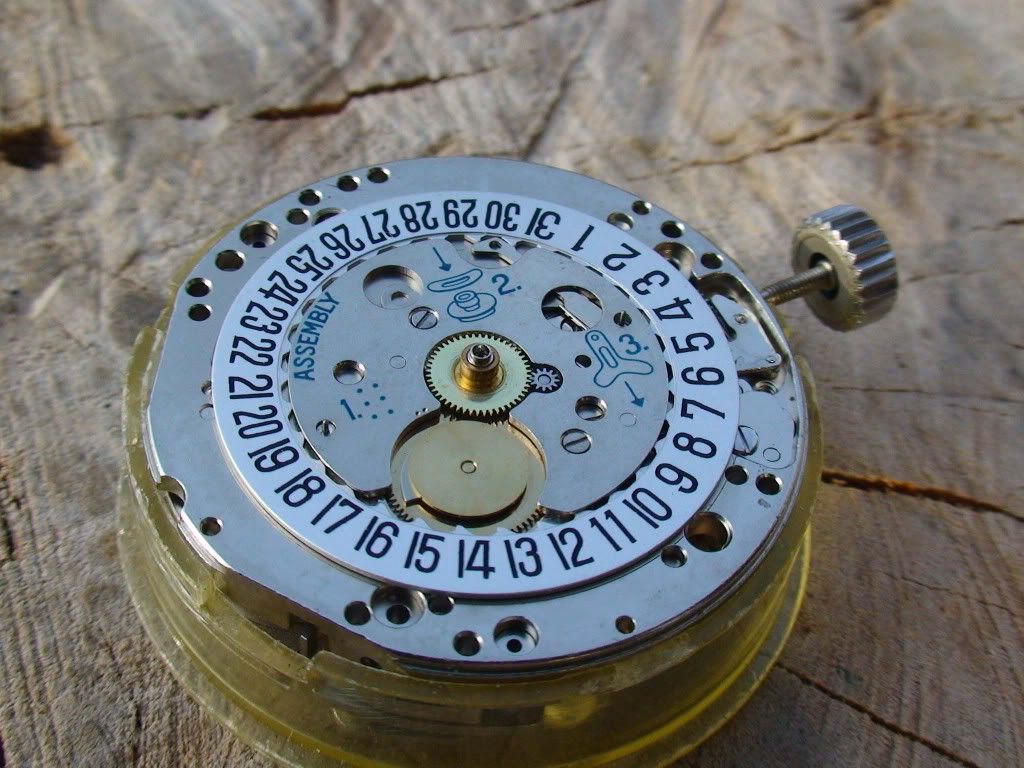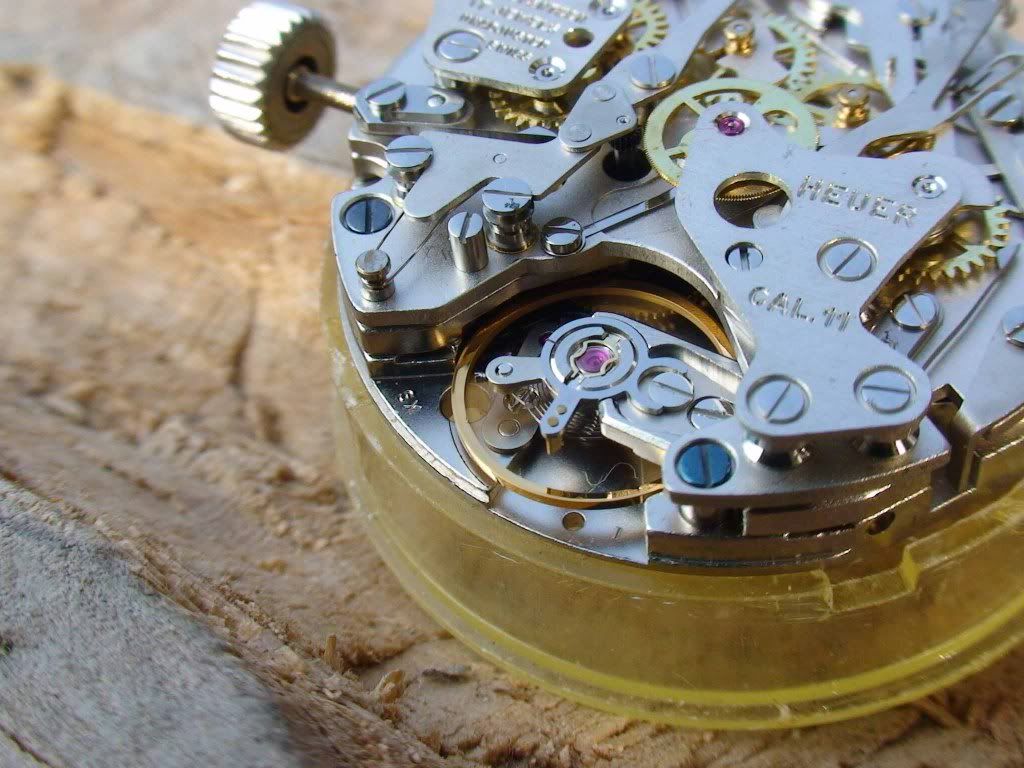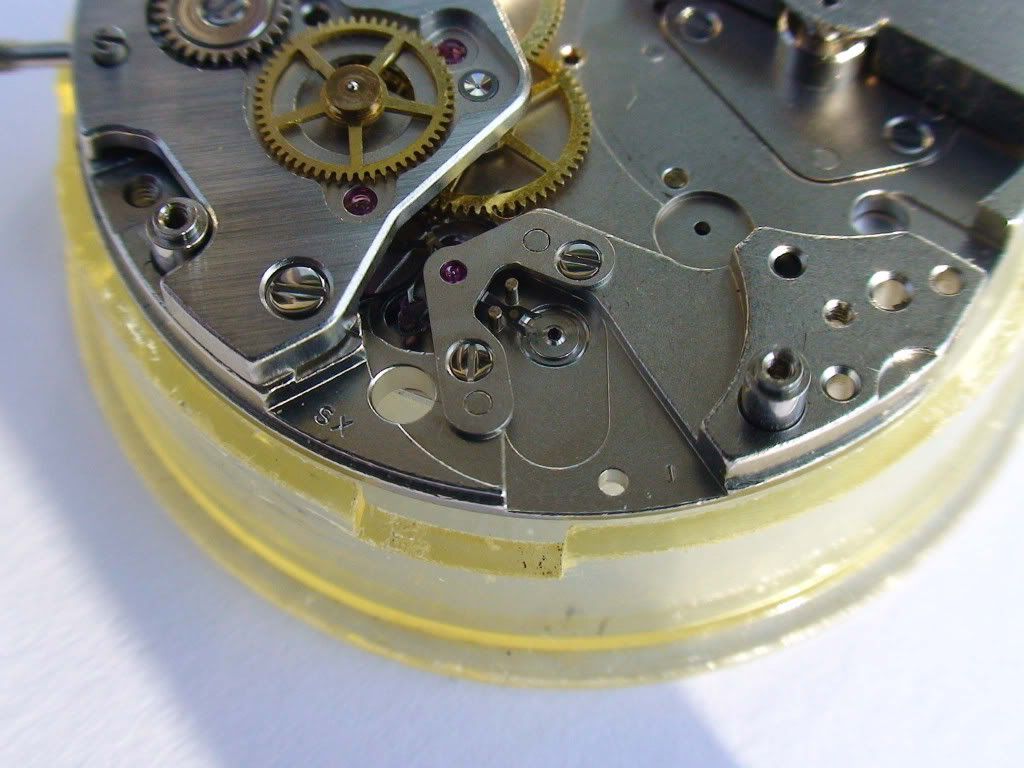| Informational Websites | ChronoMaddox -- the legacy of Chuck Maddox | OnTheDash -- vintage Heuer website | Zowie -- Omega information |
| Discussion Forums | ChronoMaddox Forum | Heuer Forum | Omega Forum |
| Counterfeit Watchers | ChronoTools Forum | ChronoTrader Forum |
|
|
The largest independent, non-commercial, consumer-oriented resource on the Internet for owners, collectors and enthusiasts of fine wristwatches. Online since 1998. | |||||||
|
||||||||
|
||||||||
 |
Vintage Heuer Discussion Forum
The place for discussing 1930-1985 Heuer wristwatches, chronographs and dash-mounted timepieces. Online since May 2003. | ||||||
| |||||||
| |||||||
This is the front of the Caliber 11 movement, this part is almost always covered by a dial :-))

This is obviously the back of the Caliber 11-I movement...as seen as we open the back of a watch...

Close-up from the balance and escape-mechanism;

And since there was no dial and hands present on this movement I decided to take off the Chronograph-module in order to take a decent photo of the additional "I" stamping on these Caliber 11-I movements...

This forum is just so great! Thank you Jeff...
Cheers,
Abel.
: In response to the discussion about the Caliber 11-I, with the
: special marking on the back of one of the lugs, let me present
: the following excerpt, taken from a draft of Part 3 of my series
: about the Chronomatics / Caliber 12 chronographs.
: I hope that you find this information interesting and useful, as
: you seek to determine whether you have a Caliber 11 or a Caliber
: 11-I. Thanks to David for raising this issue; thanks to Hans for
: providing most of the following information.
: Now, let's see who can show us some Caliber 11-I chronographs!!
: Jeff
: ++++++++++++++++++++++++++++++++++++++++++++++++++++++++++++++
: Caliber 11 -- The Early Problems
: The Caliber 11 movement was plagued with technical problems, from
: the beginning. Some of these technical problems arose from
: decisions made in designing the watches; others arose from poor
: engineering or a lack of development of the movement, as the
: Chronomatic group competed to bring the first automatic
: chronograph onto the market. The following were among the most
: significant "technical" problems with the original
: Caliber 11 chronographs:
: While most chronographs of the period utilized a “jumping”
: minute recorder and a “creeping” hour recorder, the Caliber
: 11 used a jumping hour recorder as well as a jumping minute
: recorder. The needles on the chronograph "jumped"
: every 30 minutes (and every minute), rather than moving
: continuously. Having the needle "jump" required
: incrementally more power than having them creep on a continuous
: basis.
: The Caliber 11 was also designed so that the date disk would
: "jump" in a relatively short period of time (beginning
: at 11:45 p.m.), rather than beginning to change earlier in the
: evening (for example, at 10:30 p.m.). This jumping date disk
: also required incrementally more power than a disk that would
: move more gradually over the course of a longer period.
: In order to provide the power that would be required to power the
: watch, with the chronograph running, the needles jumping, and
: the hour disk changing within a relatively short period of time,
: the Caliber 11 required a strong mainspring. The mainspring used
: for the Caliber 11 turned out to be too strong, resulting in the
: problem of "banking" (or “rebanking”), meaning
: that the balance wheel had too much amplitude and caused the
: watch to run too fast.
: Finally, the Caliber 11 movement had problems with its oscillating
: pinions, which had a brass head on a steel shaft. This brass
: head turned a brass wheel (Number 8000), and both these parts
: wore out too quickly.
: The Caliber 11-I Movement
: As a result of these technical problems with the Caliber 11
: movement, within a year of its introduction, the Chronomatic
: group (Hueer-Breitling-Hamilton) made the changes that resulted
: in the creation of the Caliber 11-I movement. (We are not
: certain, but can assume that the "I" designation
: indicated that the movement had been "Improved".)
: Changes from the original Caliber 11 to the improved Caliber
: 11-I included the following:
: changes in the mainspring and balance wheel, to address the
: problem of "banking"
: the date advance wheel (jumper) was slowed, so that the date began
: to change at 10:30 p.m. and occurred over the next 90 minutes
: the jumper springs on the minute and hour recorders were changed,
: so that less power was required for the needles to jump each
: minute and each 30 minutes.
: the oscillating pinion was changed from being bi-metallic (steel
: and brass) to solid steel, and the chronograph runner wheel
: (8000) was made of a nickel-silver alloy, rather than brass
: A collector can confirm that his Heuer chronograph is powered by
: the Caliber 11-I movement, by checking for two special
: marks. The main chronograph bridge will be marked with the usual
: "11", but there will be a small "I"
: under the balance wheel. In addition, the case of any
: chronograph that used the Caliber 11-I movement was marked with
: a small star (*) on the back of one of the four lugs.
: In addition, the color of the barrel changed from rose
: color in the Caliber 11 to nickel-plated in the Caliber
: 11-I. Finally, whereas the date change on the the
: Caliber 11 began shortly before midnight (at around 11:45), the
: date change on the Caliber 11-I will begin much earlier, at
: around 10:30.
: ++++++++++++++++++++++++++++++++++++++++++++++++++++++++++++++++
: In the following photo, notice the small "I", at the very
: bottom, below the balance wheel, indicating that this is an
: "Improved" (or modified) Caliber 11 movement.
:
| Chronocentric and zOwie site design and contents (c) Copyright 1998-2005, Derek Ziglar; Copyright 2005-2008, Jeffrey M. Stein. All rights reserved. Use of this web site constitutes acceptance of the terms of use. | CONTACT | TERMS OF USE | TRANSLATE |